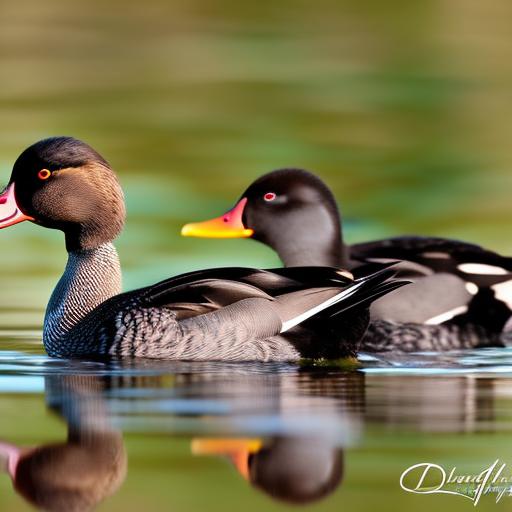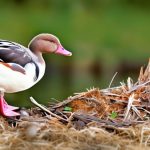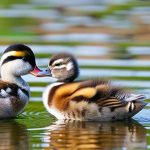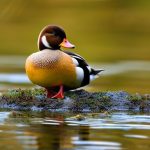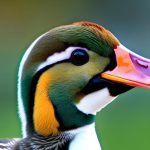Black ducks are a species of waterfowl that are native to North America. They are known for their dark plumage and distinctive quacking sound. Black ducks are interesting because they have a unique breeding behavior and are also an important part of the ecosystem. They play a crucial role in maintaining the balance of wetland habitats and are often used as an indicator species for the health of these environments.
Key Takeaways
- Black ducks are a species of waterfowl found in North America, Europe, and Asia.
- They have dark brown plumage, a yellow bill, and orange legs.
- Black ducks prefer freshwater habitats such as wetlands, ponds, and streams.
- Their diet consists of aquatic plants, insects, and small animals.
- Black ducks have been bred in captivity for conservation purposes, but hybridization with mallards poses a threat to their genetic purity.
Physical Characteristics of Black Ducks
Black ducks are medium-sized ducks, with males typically weighing between 2.5 and 3 pounds, and females weighing slightly less. They have a wingspan of about 32 inches and a body length of around 22 inches. The plumage of black ducks is predominantly dark brown, with lighter brown feathers on their chest and belly. They have a distinctive yellowish bill and dark eyes.
One of the distinguishing features of black ducks is their dark coloration, which gives them their name. However, it is important to note that not all black ducks are completely black. Some individuals may have lighter feathers on their head or wings, while others may have a mottled appearance. This variation in coloration can make it difficult to identify black ducks in the wild.
Distribution and Habitat of Black Ducks
Black ducks can be found throughout North America, from the eastern coast of Canada to the Gulf of Mexico. They prefer to inhabit wetland areas such as marshes, swamps, and ponds, where they can find ample food and nesting sites. Black ducks are adaptable birds and can also be found in agricultural fields and other open habitats.
In terms of their distribution, black ducks are most commonly found in the northeastern United States and eastern Canada. They are also present in parts of the Midwest and along the Atlantic coast. However, their numbers have declined in recent years due to habitat loss and other factors.
Behavior and Diet of Black Ducks
Black ducks are primarily herbivorous and feed on a variety of plant materials, including seeds, aquatic vegetation, and grasses. They also consume small invertebrates such as insects and snails. Black ducks are dabbling ducks, which means they feed by tipping their heads underwater and grazing on the surface of the water.
In terms of behavior, black ducks are social birds and often form small flocks during the non-breeding season. They are known for their distinctive quacking sound, which is used to communicate with other ducks. Black ducks are also strong fliers and can migrate long distances to find suitable breeding and wintering grounds.
History of Black Duck Breeding
Black ducks have been bred and domesticated for centuries. The exact origins of black duck breeding are unclear, but it is believed that they were first domesticated in Asia and then brought to Europe by traders. In Europe, black ducks were bred for their meat and eggs, as well as for their ornamental value.
In North America, black ducks were initially hunted for their meat and feathers. However, as the demand for wild game declined, efforts were made to breed black ducks in captivity. These breeding programs aimed to preserve the genetic diversity of black ducks and ensure their long-term survival.
Mallard-Black Duck Hybridization
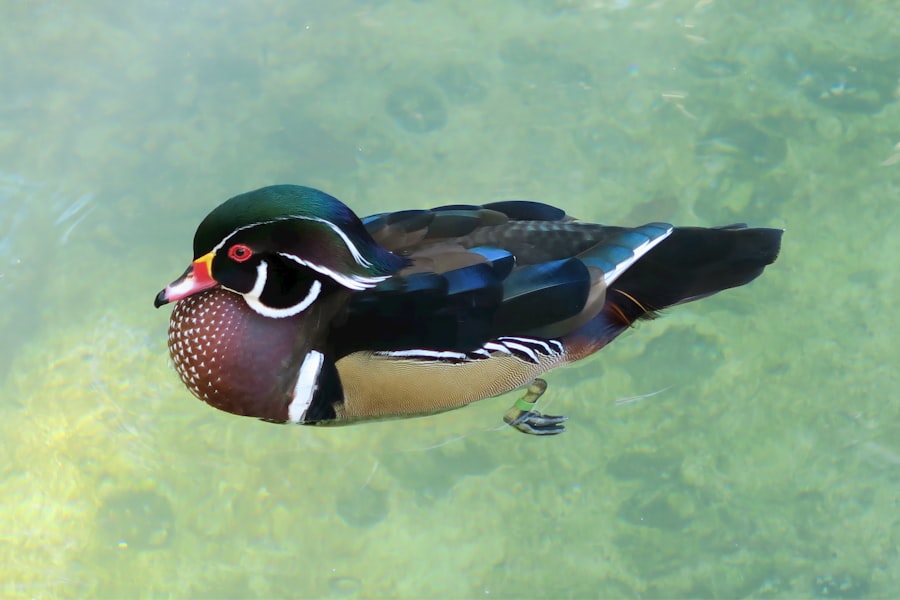
One of the challenges facing black duck populations is hybridization with mallards. Mallards are a closely related species of duck that can interbreed with black ducks, producing hybrid offspring. This hybridization can result in the loss of genetic diversity in black duck populations and may also lead to the displacement of purebred black ducks.
Hybridization between black ducks and mallards is a natural process that has been occurring for thousands of years. However, human activities such as habitat destruction and the release of captive-bred mallards have increased the frequency of hybridization in recent years.
Conservation Status of Black Ducks
The conservation status of black ducks is a matter of concern. While they are not currently listed as endangered, their populations have declined significantly in recent decades. The main threats to black ducks include habitat loss, pollution, hunting, and hybridization with mallards.
Efforts are being made to conserve black duck populations through habitat restoration, captive breeding programs, and the regulation of hunting. These conservation measures aim to protect the remaining black duck populations and ensure their long-term survival.
Black Duck Breeds in North America
In North America, there are several breeds of black ducks that are recognized by poultry organizations. These breeds include the American Black Duck, the Cayuga Duck, and the East Indies Duck.
The American Black Duck is the most common breed of black duck in North America. It is a medium-sized duck with dark plumage and a distinctive quacking sound. The Cayuga Duck is a breed that was developed in the United States and is known for its black feathers with a greenish sheen. The East Indies Duck is a small breed of black duck that is native to North America.
Black Duck Breeds in Europe and Asia
In Europe and Asia, there are also several breeds of black ducks that are recognized by poultry organizations. These breeds include the Rouen Clair Duck, the Swedish Blue Duck, and the Indian Runner Duck.
The Rouen Clair Duck is a breed that was developed in France and is known for its large size and distinctive coloration. The Swedish Blue Duck is a breed that was developed in Sweden and is known for its blue feathers and upright posture. The Indian Runner Duck is a breed that was developed in India and is known for its slender body and upright stance.
Black Duck Breeding Programs and Challenges
Black duck breeding programs face several challenges, including habitat loss, pollution, hunting, and hybridization with mallards. These challenges can make it difficult to maintain the genetic diversity of black duck populations and ensure their long-term survival.
To address these challenges, conservation organizations are working to protect and restore black duck habitats, regulate hunting, and reduce the impact of hybridization. These efforts aim to preserve the genetic diversity of black ducks and ensure their continued existence in the wild.
If you’re interested in learning more about black duck breeds, you might also find this article on chicken coop designs helpful. It provides valuable insights into creating a suitable and comfortable living space for your ducks. From tips on insulating the coop to innovative ideas like using a chicken coop trampoline, this article from Poultry Wizard offers practical advice for ensuring the well-being of your black ducks. Check it out here.
FAQs
What are black ducks?
Black ducks are a type of waterfowl that are native to North America. They are medium-sized ducks with dark plumage and a distinctive yellow bill.
What breeds of black ducks are there?
There are several breeds of black ducks, including the American black duck, the eastern black duck, and the Mexican black duck.
What is the American black duck?
The American black duck is a breed of black duck that is found in eastern North America. It is a medium-sized duck with dark plumage and a yellow bill. It is a popular game bird and is also kept as a pet.
What is the eastern black duck?
The eastern black duck is a breed of black duck that is found in Australia and New Zealand. It is a medium-sized duck with dark plumage and a yellow bill. It is a popular game bird and is also kept as a pet.
What is the Mexican black duck?
The Mexican black duck is a breed of black duck that is found in Mexico and Central America. It is a medium-sized duck with dark plumage and a yellow bill. It is a popular game bird and is also kept as a pet.
What is the habitat of black ducks?
Black ducks are found in a variety of wetland habitats, including marshes, swamps, and ponds. They prefer areas with dense vegetation and shallow water.
What do black ducks eat?
Black ducks are omnivores and eat a variety of foods, including aquatic plants, insects, crustaceans, and small fish.
Are black ducks endangered?
The American black duck is considered a species of concern by the U.S. Fish and Wildlife Service due to habitat loss and hybridization with mallards. The eastern black duck and Mexican black duck are not considered endangered.
Meet Walter, the feathered-friend fanatic of Florida! Nestled in the sunshine state, Walter struts through life with his feathered companions, clucking his way to happiness. With a coop that’s fancier than a five-star hotel, he’s the Don Juan of the chicken world. When he’s not teaching his hens to do the cha-cha, you’ll find him in a heated debate with his prized rooster, Sir Clucks-a-Lot. Walter’s poultry passion is no yolk; he’s the sunny-side-up guy you never knew you needed in your flock of friends!

